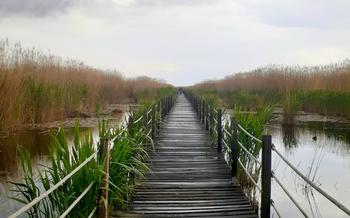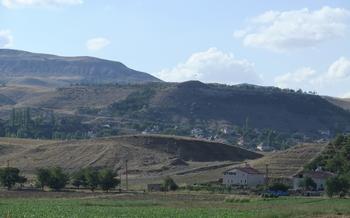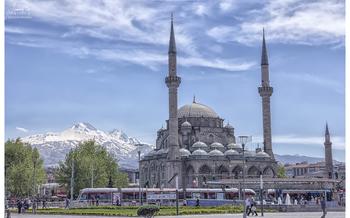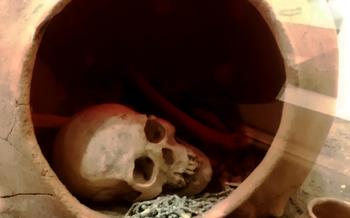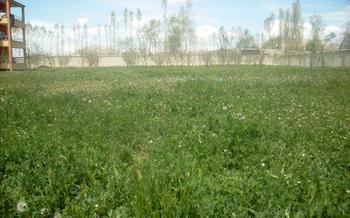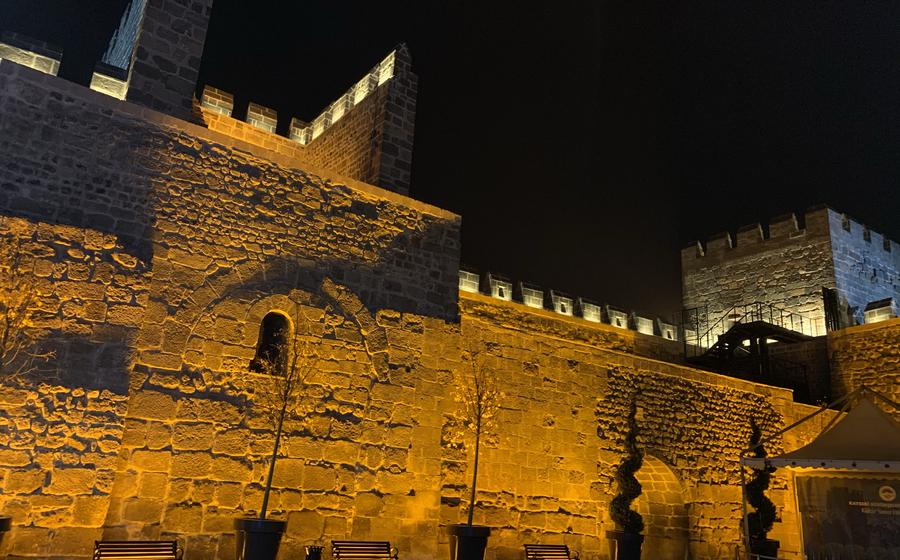
Selçuklu Museum
- Historical Background
- Location and Accessibility:
- Architectural Marvel
- Exhibits and Collections
- Interactive Displays
- Cultural Insights
- Guided Tours
- Museum Shop and Souvenirs
- Accessibility for All
- Educational Programs
- Photography and Videography
- Local Cuisine: A Culinary Adventure in Kayseri
- Nearby Attractions
- Insider Tip:
Historical Background
Kayseri, a city nestled in the heart of Turkey, boasts a rich history deeply intertwined with the Seljuk dynasty. The Seljuks, a powerful nomadic tribe of Turkic origin, emerged in the 11th century and established a vast empire that stretched from Central Asia to Anatolia. Their arrival in Anatolia marked a significant turning point in the region's history and culture. The Seljuks brought with them a blend of nomadic and Islamic traditions, which profoundly influenced the development of art, architecture, and governance in the region.
Kayseri, strategically positioned on the Silk Road, became a major center of Seljuk rule and a flourishing hub of trade and commerce. The Seljuks transformed the city, leaving behind a legacy of architectural marvels, including mosques, madrasahs, and caravanserais. The Selçuklu Museum, housed in a magnificent former caravanserai, stands as a testament to the Seljuk dynasty's enduring impact on Kayseri and the surrounding region.
Location and Accessibility:
The Selçuklu Museum is strategically situated in the heart of Kayseri, a city steeped in history and culture. Located in the city center, the museum is easily accessible by various modes of transportation. Visitors can take advantage of the convenient public transportation system, with bus stops and tram stations located nearby. The museum's proximity to notable landmarks, such as the Kayseri Castle and the Grand Mosque, serves as a valuable reference point for navigation. Its central location allows visitors to seamlessly integrate their visit to the museum with other sightseeing activities, creating a comprehensive cultural itinerary. The museum's operating hours typically fall between 8:00 AM and 5:00 PM, providing ample time for exploration. Admission fees are nominal, ensuring that visitors can enjoy the museum's treasures without breaking the bank.
Architectural Marvel
The Selçuklu Museum stands as a testament to the architectural prowess of the Seljuk dynasty. Its striking façade showcases intricate carvings, decorative tiles, and elegant arches that blend Islamic and Anatolian architectural styles. The museum's courtyard features a serene central pool surrounded by arched walkways, creating a tranquil ambiance that invites visitors to explore further.
Inside the museum, visitors are greeted by a spacious hall with soaring ceilings and grand columns. The walls are adorned with intricate tilework depicting geometric patterns, floral motifs, and scenes from Seljuk history. The museum's exhibits are housed in various rooms and galleries, each showcasing different aspects of Seljuk culture and craftsmanship.
The museum's architecture has undergone extensive restoration and preservation efforts to maintain its original splendor. These efforts have successfully preserved the building's historical integrity and ensured that visitors can appreciate its architectural beauty for generations to come.
Exhibits and Collections
The Selçuklu Museum houses a treasure trove of artifacts and exhibits that provide a glimpse into the rich cultural heritage of the Seljuk dynasty. Among the must-see items are intricate metalwork pieces, including stunning examples of jewelry, tableware, and decorative objects. These artifacts showcase the exceptional craftsmanship and artistry of the Seljuk artisans, who were renowned for their mastery of metalworking techniques.
The museum also boasts an impressive collection of ceramics, including glazed pottery and tiles. These ceramics not only offer insights into the daily life and customs of the Seljuks but also serve as beautiful examples of Islamic art. Visitors can admire the vibrant colors, intricate patterns, and calligraphy that adorn these ceramic pieces.
Of particular significance is the collection of manuscripts and illuminated Qur'ans housed in the museum. These manuscripts, with their exquisite calligraphy and intricate illustrations, represent the pinnacle of Islamic bookmaking. They provide valuable insights into the religious, intellectual, and artistic traditions of the Seljuk period.
Additionally, the museum showcases a variety of textiles, including carpets and embroideries, that demonstrate the Seljuks' mastery of textile arts. These intricate textiles, with their vibrant colors and intricate patterns, reflect the sophisticated tastes and craftsmanship of the Seljuk artisans.
Interactive Displays
The Selçuklu Museum embraces modern technology to enhance the visitor experience through interactive displays and multimedia presentations. These interactive elements bring history to life, allowing visitors to engage with the exhibits in a dynamic and educational way.
One of the highlights is the interactive map of the Seljuk Empire. Visitors can explore the vast extent of the empire, learn about its major cities, and trace the routes of important historical events. The map is equipped with touch screens that provide additional information and context.
Another interactive exhibit showcases replicas of Seljuk instruments and musical performances. Visitors can listen to traditional melodies and learn about the role of music in Seljuk culture. Interactive games and quizzes challenge visitors to test their knowledge of Seljuk history and culture.
These interactive displays are particularly valuable for children and students, as they offer a fun and engaging way to learn about the past. They stimulate curiosity and encourage visitors to explore the museum's collections in greater depth.
Cultural Insights
The Selçuklu Museum offers a profound journey into the cultural heritage of the Seljuk people. Through its diverse exhibits and artifacts, visitors gain insights into the daily life, customs, and traditions that shaped Seljuk society. The intricate designs, motifs, and symbolism found in the artifacts provide a glimpse into the artistic expression and craftsmanship of the Seljuks.
The museum showcases examples of Seljuk pottery, textiles, metalwork, and woodwork, each reflecting the unique blend of Islamic and Anatolian influences. Visitors can admire the exquisite calligraphy and illumination that adorned manuscripts, marvel at the intricate tilework that decorated Seljuk architecture, and appreciate the delicate jewelry that adorned the people of the time.
By exploring the cultural artifacts in the Selçuklu Museum, visitors can gain a deeper understanding of the Seljuks' contributions to art, architecture, and craftsmanship. The museum provides a platform for preserving and celebrating the rich cultural legacy of this influential dynasty that left an enduring impact on the region's history and identity.
Guided Tours
The Selçuklu Museum offers guided tours in various languages, including English, Turkish, and Arabic. These tours provide visitors with an in-depth understanding of the museum's exhibits and the historical context of the Seljuk Empire. Knowledgeable guides lead the tours, sharing fascinating insights into the artifacts, architecture, and cultural significance of the museum's collection.
Booking a guided tour is highly recommended, especially for first-time visitors or those seeking a deeper understanding of Seljuk history. Guided tours allow visitors to ask questions, engage in discussions, and gain a comprehensive overview of the museum's highlights. It's advisable to book a tour in advance, particularly during peak tourist season, to secure a spot and avoid disappointment.
Museum Shop and Souvenirs
Within the Selçuklu Museum, visitors will find a well-stocked museum shop that offers a variety of unique souvenirs and replicas inspired by Seljuk art and craftsmanship. The shop is conveniently located within the museum premises and operates during the same hours as the museum itself. Visitors can browse through a diverse selection of items, including intricate replicas of Seljuk jewelry, miniature pottery, handwoven textiles, and decorative items inspired by Seljuk motifs. These souvenirs serve as tangible mementos of the museum visit and provide an opportunity for visitors to take a piece of Seljuk history home with them.
The museum shop also plays a crucial role in supporting the museum's preservation and educational programs. A portion of the proceeds from sales directly contributes to ongoing conservation efforts, research projects, and educational initiatives aimed at promoting cultural awareness and historical knowledge. By purchasing souvenirs from the museum shop, visitors not only take home a cherished reminder of their visit but also contribute to the preservation and promotion of Seljuk heritage.
Accessibility for All
The Selçuklu Museum is committed to providing an inclusive and welcoming environment for visitors of all abilities. The museum features accessible entrances, ramps, and elevators to ensure that visitors with disabilities can easily navigate the exhibits. Wheelchair-accessible restrooms are also available for convenience.
To enhance the experience for visually impaired visitors, the museum offers audio guides and descriptive panels in both Turkish and English. These guides provide detailed descriptions of the exhibits, allowing visitors to fully appreciate the museum's collection.
Additionally, the museum organizes special programs and events designed for visitors with disabilities. These programs may include guided tours with sign language interpretation, tactile tours for visitors with visual impairments, and workshops that focus on inclusive art experiences.
By catering to the needs of all visitors, the Selçuklu Museum strives to create a welcoming and enriching environment where everyone can learn about the rich history and culture of the Seljuk dynasty.
Educational Programs
The Selçuklu Museum actively promotes cultural awareness and historical knowledge through its diverse range of educational programs and workshops. These programs are designed to engage visitors of all ages, from curious children to eager history enthusiasts.
One of the most popular programs is the interactive workshop on Seljuk art and architecture. This hands-on experience allows participants to create their own miniature replicas of Seljuk architectural wonders, using traditional materials and techniques. The workshop provides a unique opportunity to learn about the intricate craftsmanship and design principles that characterized Seljuk architecture.
Another popular program is the storytelling session for children, which brings to life the fascinating tales and legends of the Seljuk era. Through these stories, children can gain insights into the customs, traditions, and values of the Seljuk people.
In addition to these regular programs, the museum also organizes special workshops and lectures on specific topics related to Seljuk history and culture. These events often feature renowned scholars and experts in their respective fields, providing visitors with an opportunity to learn from the leading authorities on Seljuk studies.
Overall, the Selçuklu Museum's educational programs offer a valuable and engaging way to deepen one's understanding of Seljuk history, art, and culture. Visitors of all ages are encouraged to participate in these programs to gain a more immersive and enriching experience.
Photography and Videography
Respecting the guidelines of the Selçuklu Museum is paramount when it comes to capturing the beauty of its exhibits through photography or videography. While the museum encourages visitors to take photographs and videos for personal use, flash photography and the use of tripods are strictly prohibited to ensure the preservation of the artifacts. The museum's staff is available to assist visitors with any questions or concerns regarding photography and videography policies. Visitors are encouraged to take advantage of the museum's unique architectural features and stunning displays as subjects for their photographs, capturing the essence of Seljuk history and artistry.
Local Cuisine: A Culinary Adventure in Kayseri
After immersing yourself in the rich history and culture of the Selçuklu Museum, embark on a culinary journey that will tantalize your taste buds and introduce you to the vibrant flavors of Kayseri. Just a stone's throw from the museum, you'll find an array of local restaurants and eateries that offer a delectable selection of traditional Turkish cuisine.
Indulge in the must-try dish of mantı, delicate dumplings filled with minced lamb and topped with garlic yogurt and melted butter. Savor the succulent flavors of Kayseri tava, tender lamb cooked with fresh vegetables in a clay pot. Delight in the crispy layers of yağlama, a traditional flatbread brushed with butter and topped with minced meat, vegetables, or cheese.
For a sweet treat, don't miss Kayseri's famous künefe, a filo pastry filled with shredded kadayıf dough, cheese, and sugar syrup, baked until golden brown and served hot. Wash it all down with a refreshing glass of şerbet, a sweet fruit-based beverage.
As you savor these culinary delights, remember that Kayseri's cuisine is a reflection of its rich cultural heritage. The flavors and aromas of these dishes have been passed down through generations, embodying the essence of Kayseri's unique culinary identity. Embrace this opportunity to experience the true taste of Turkey in the heart of Kayseri.
Nearby Attractions
After exploring the rich history and culture of the Seljuk dynasty at the Selçuklu Museum, visitors can venture into the heart of Kayseri to discover a wealth of other captivating landmarks and attractions. Just a short walk from the museum, the majestic Hunat Hatun Complex stands as a testament to the architectural prowess of the Seljuks. This stunning complex, which includes a mosque, a madrasa, and a tomb, is a must-visit for anyone interested in Islamic architecture.
For those fascinated by history, the Kayseri Castle, located on a hill overlooking the city, offers a glimpse into the region's past. This imposing fortress, built by the Byzantines and later expanded by the Seljuks, served as a strategic military stronghold for centuries. Visitors can explore the castle's ramparts, towers, and dungeons, immersing themselves in the tales of battles and sieges that shaped Kayseri's history.
Nature enthusiasts will find solace in the nearby Erciyes Mountain, an extinct volcano that dominates the Kayseri skyline. With its stunning landscapes, lush forests, and snow-capped peaks, Erciyes offers a variety of outdoor activities, including hiking, skiing, and mountain climbing. Visitors can take a cable car to the summit for breathtaking panoramic views of the city and the surrounding countryside.
Kayseri is also renowned for its vibrant culinary scene. After a day of exploration, indulge in a feast of traditional Turkish cuisine at one of the many restaurants and eateries in the city center. Sample mouthwatering dishes such as Kayseri mantısı (handmade dumplings), yağlama (a layered flatbread), and künefe (a sweet pastry filled with cheese and pistachios).
Combining a visit to the Selçuklu Museum with these nearby attractions creates a well-rounded cultural experience that showcases the diverse heritage and beauty of Kayseri. Whether you're a history buff, an architecture enthusiast, or simply seeking natural wonders, Kayseri offers something for every traveler.
Insider Tip:
For an unforgettable visit, plan your trip to the Selçuklu Museum during the annual Kayseri International Culture and Art Festival. Held in September, this vibrant festival showcases traditional Turkish music, dance, handicrafts, and culinary delights. Immerse yourself in the lively atmosphere, witness colorful parades, and experience the rich cultural heritage of Kayseri come to life. Don't miss this opportunity to delve deeper into the region's history and traditions while enjoying a vibrant celebration of Turkish culture.
